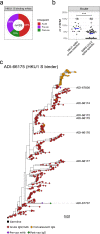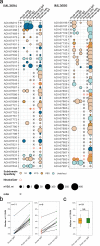Vaccination of SARS-CoV-2-infected individuals expands a broad range of clonally diverse affinity-matured B cell lineages
- PMID: 37076511
- PMCID: PMC10115384
- DOI: 10.1038/s41467-023-37972-1
Vaccination of SARS-CoV-2-infected individuals expands a broad range of clonally diverse affinity-matured B cell lineages
Abstract
Vaccination of SARS-CoV-2 convalescent individuals generates broad and potent antibody responses. Here, we isolate 459 spike-specific monoclonal antibodies (mAbs) from two individuals who were infected with the index variant of SARS-CoV-2 and later boosted with mRNA-1273. We characterize mAb genetic features by sequence assignments to the donors' personal immunoglobulin genotypes and assess antibody neutralizing activities against index SARS-CoV-2, Beta, Delta, and Omicron variants. The mAbs used a broad range of immunoglobulin heavy chain (IGH) V genes in the response to all sub-determinants of the spike examined, with similar characteristics observed in both donors. IGH repertoire sequencing and B cell lineage tracing at longitudinal time points reveals extensive evolution of SARS-CoV-2 spike-binding antibodies from acute infection until vaccination five months later. These results demonstrate that highly polyclonal repertoires of affinity-matured memory B cells are efficiently recalled by vaccination, providing a basis for the potent antibody responses observed in convalescent persons following vaccination.
© 2023. The Author(s).
Conflict of interest statement
M.S., C.G.R., and H.L.D. are employees of Adimab LLC. and own equity stake in Adimab LLC. L.M.W. is an employee of Invivyd Inc. and owns shares in Invivyd Inc. The remaining authors declare no competing interests.
Figures





Similar articles
-
Emerging Variants of SARS-CoV-2 and Novel Therapeutics Against Coronavirus (COVID-19).2023 May 8. In: StatPearls [Internet]. Treasure Island (FL): StatPearls Publishing; 2025 Jan–. 2023 May 8. In: StatPearls [Internet]. Treasure Island (FL): StatPearls Publishing; 2025 Jan–. PMID: 34033342 Free Books & Documents.
-
Neutralisation sensitivity of the SARS-CoV-2 omicron (B.1.1.529) variant: a cross-sectional study.Lancet Infect Dis. 2022 Jun;22(6):813-820. doi: 10.1016/S1473-3099(22)00129-3. Epub 2022 Mar 17. Lancet Infect Dis. 2022. PMID: 35305699 Free PMC article.
-
Analysis of B Cell Receptor Repertoires Reveals Key Signatures of the Systemic B Cell Response after SARS-CoV-2 Infection.J Virol. 2022 Feb 23;96(4):e0160021. doi: 10.1128/JVI.01600-21. Epub 2021 Dec 8. J Virol. 2022. PMID: 34878902 Free PMC article.
-
Identification and Analysis of Monoclonal Antibodies with Neutralizing Activity against Diverse SARS-CoV-2 Variants.J Virol. 2023 Jun 29;97(6):e0028623. doi: 10.1128/jvi.00286-23. Epub 2023 May 16. J Virol. 2023. PMID: 37191569 Free PMC article.
-
Resistance of SARS-CoV-2 variants to neutralization by antibodies induced in convalescent patients with COVID-19.Cell Rep. 2021 Jul 13;36(2):109385. doi: 10.1016/j.celrep.2021.109385. Epub 2021 Jun 25. Cell Rep. 2021. PMID: 34237284 Free PMC article.
Cited by
-
Naive and Memory B Cell BCR Repertoires in Individuals Immunized with an Inactivated SARS-CoV-2 Vaccine.Vaccines (Basel). 2025 Apr 8;13(4):393. doi: 10.3390/vaccines13040393. Vaccines (Basel). 2025. PMID: 40333337 Free PMC article.
-
Disease diagnostics using machine learning of B cell and T cell receptor sequences.Science. 2025 Feb 21;387(6736):eadp2407. doi: 10.1126/science.adp2407. Epub 2025 Feb 21. Science. 2025. PMID: 39977494 Free PMC article.
-
Navigating the Landscape of B Cell Mediated Immunity and Antibody Monitoring in SARS-CoV-2 Vaccine Efficacy: Tools, Strategies and Clinical Trial Insights.Vaccines (Basel). 2024 Sep 24;12(10):1089. doi: 10.3390/vaccines12101089. Vaccines (Basel). 2024. PMID: 39460256 Free PMC article. Review.
-
Dissecting human monoclonal antibody responses from mRNA- and protein-based XBB.1.5 COVID-19 monovalent vaccines.bioRxiv [Preprint]. 2024 Jul 16:2024.07.15.602781. doi: 10.1101/2024.07.15.602781. bioRxiv. 2024. Update in: Lancet Microbe. 2025 Aug;6(8):101103. doi: 10.1016/j.lanmic.2025.101103. PMID: 39071292 Free PMC article. Updated. Preprint.
-
Detection of PCR chimeras in adaptive immune receptor repertoire sequencing using hidden Markov models.bioRxiv [Preprint]. 2025 Feb 26:2025.02.21.638809. doi: 10.1101/2025.02.21.638809. bioRxiv. 2025. PMID: 40060431 Free PMC article. Preprint.
References
Publication types
MeSH terms
Substances
Supplementary concepts
Grants and funding
LinkOut - more resources
Full Text Sources
Medical
Miscellaneous

